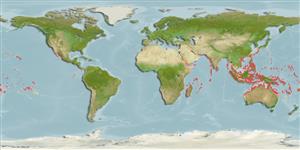Teleostei (teleosts) >
Anguilliformes (Eels and morays) >
Ophichthidae (Snake eels) > Ophichthinae
Etymology: Ophichthus: Greek, ophis = serpent + Greek, ichthys = fish (Ref. 45335).
Eponymy: Prince Charles Lucien Bonaparte (originally Jules Laurent Lucien) (1803–1857) was a nephew of Napoleon Bonaparte and a renowned biologist and zoologist. [...] (Ref. 128868), visit book page.
More on author: Kaup.
Environment: milieu / climate zone / depth range / distribution range
Ecology
Marine; reef-associated; depth range 1 - 20 m (Ref. 3972). Tropical
Indo-Pacific: off Durban, South Africa, then from Mauritius to Indonesia; north to Japan, south to Australia.
Size / Weight / Age
Maturity: Lm ? range ? - ? cm
Max length : 75.0 cm TL male/unsexed; (Ref. 3972)
Short description
Identification keys | Morphology | Morphometrics
Vertebrae: 156 - 164. Golden yellow to cream with 18-27 prominent black saddles, a few meeting below (Ref. 3972). Dorsal and anal margin with irregular spots and golden marbling and spots on snout and head (Ref. 3972). Body broadly banded with black and white (Ref. 48635).
Inhabits sand flats of lagoon and seaward reefs to a depth of over 20 m (Ref. 37816). Burrowing species of inshore waters (Ref. 75154). Feeds on small fishes, and probably crustaceans (Ref. 89972). Only the head is usually visible from the sand during the day (Ref. 48635). Solitary in sand (Ref 90102). Minimum depth reported taken from Ref. 86942.
Life cycle and mating behavior
Maturity | Reproduction | Spawning | Eggs | Fecundity | Larvae
McCosker, J.E. and P.H.J. Castle, 1986. Ophichthidae. p. 176-186. In M.M. Smith and P.C. Heemstra (eds.) Smiths' sea fishes. Springer-Verlag, Berlin. (Ref. 3972)
IUCN Red List Status (Ref. 130435: Version 2024-1)
Threat to humans
Harmless
Human uses
Fisheries: of no interest
Tools
Special reports
Download XML
Internet sources
Estimates based on models
Preferred temperature (Ref.
123201): 24.7 - 29.3, mean 28.3 °C (based on 2421 cells).
Phylogenetic diversity index (Ref.
82804): PD
50 = 0.5000 [Uniqueness, from 0.5 = low to 2.0 = high].
Bayesian length-weight: a=0.00091 (0.00039 - 0.00215), b=2.99 (2.79 - 3.19), in cm total length, based on LWR estimates for this (Sub)family-body shape (Ref.
93245).
Trophic level (Ref.
69278): 4.0 ±0.7 se; based on size and trophs of closest relatives
Resilience (Ref.
120179): Medium, minimum population doubling time 1.4 - 4.4 years (Preliminary K or Fecundity.).
Fishing Vulnerability (Ref.
59153): Moderate to high vulnerability (50 of 100).
